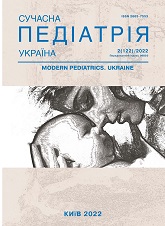Differential diagnostics critical illness myopathy and their medical management in children
DOI:
https://doi.org/10.15574/SP.2022.122.72Keywords:
critical illness myopathy, X-linked miotubular myopathy, spinal muscular atrophy, disease-modified therapyAbstract
Critical illness myopathy (CIM) is a challenging problem for identifying which impacts on verified diagnosis in time. CIM occurs often as one of respiratory failure cause for intensive care admission and invasive ventilation is needed and subsequent inability to wean from the ventilator. It also influences on the length period of patient’s staying in the intensive care unit (ICU).
Purpose - to provide the analysis of clinical signs of CIM in children and their medical management.
Materials and methods. We examined the group of children aged from 3 month up to 15 years old. Patients were needed critical care in ICU. We utilized clinical, instrumental and laboratory methods of investigation.
Results. We have carried out differential diagnostics and the causes of CIM in presented clinical cases which have been shown. Neuromuscular causes of weakness in the children have been identified. X-linked myotubular myopathy was the cause for CIM in the first patient. Muscular weakness in patient with spinal muscular atrophy (SMA) combined with pneumonia and sepsis was the reason for critical care in the next patient. Prescribed antibacterial therapy combined with symptomatic one in the patient with X-linked miotubular myopathy as well as the antibacterial therapy connected with the disease-modified medicine and respiratory support in the patient with SMA showed positive result of treatment.
Conclusions. Diffuse muscular hypotonia, hyporeflexia, muscular weakness were main clinical signs of CIM in the patient with X-linked miotubular myopathy as well as in the patient with SMA, type I. Presented symptoms appeared from the child’s newborn period. The prescribed disease-modified therapy combined with antibacterial one and respiratory support proved effectiveness and allowed us to wean the patient from the ventilator.
The research was carried out in accordance with the principles of the Helsinki declaration. The informed consent of the patient was obtained for conducting the studies.
No conflict of interests was declared by the authors.
References
Biancalana V, Scheidecker S, Miguet M, Laquerriere A et al. (2017). Affected female carriers of MTM1 mutations display a wide spectrum of clinical and pathological involvement: delineating diagnostic clues. Acta Neuropathol. 134 (6): 889-904. https://doi.org/10.1007/s00401-017-1748-0; PMid:28685322
Birnkrant D, Bushby K, Bann C, Apkon S, Blackwell A and others. (2018). Diagnosis and management of Duchenne muscular dystrophy, part 1: diagnosis and muscular rehabilitation, endocrine and gastrointestinal and nutritional management. Lancet Neurology. URL: https://www.thelancet.com/neurology/. https://doi.org/10.1016/S1474-4422(18)30024-3
Bolton CF. (2005). Neuromuscular manifestation of critical illness. Muscle Nerve. 32 (2): 140-163. https://doi.org/10.1002/mus.20304; PMid:15825186
Cheryl D, Napolitano N, Wolfe H, Rhodes L, Kelly M, Panitch H, Mayer O. (2021). Implementation of Spinal Muscular Atrophy Pathway Reduces Length of Stay. Respiratory Care. 66: 10. doi: 3608844.
Damian M, Edel L, Roj S. (2021). Nevidkladna ta ekstrena medychna dopomoga ditjam zi spinalnoju mijazovoju atrofieju. Socialna pediatrija ta reabilitologija. 1 (21): 42-52.
Dhillon S. (2020). Risdiplam: First Approval. Drugs. 80: 1853-1858. https://doi.org/10.1007/s40265-020-01410-z; PMid:33044711
Evtushenko SK, Evtushenko OS, Suhonosova OYu. (2016). Neurologiya rannego detskogo vosrasta. Neurology of early children's age. Kiev: Zaslavsky O: 288.
Evtushenko SK, Shajmurzin MR, Evtushenko OS, Evtushenko IS. (2014). Neuromyshechnye zabolevaniya u detey. Neuromuscular Diseases in Children. Donetsk: Knowledge: 218.
Finkel RS et al. (2017). Diagnosis and management of spinal muscular atrophy: Part 2: Pulmonary and acute care; medications, supplements and immunizations; other organ systems and ethics. Neuromuscular disorders. https://doi.org/10.1016/j.nmd.2017.11.004; PMid:29305137
Finkel RS, Bishop KM, Nelson RM. (2017). Spinal muscular atrophy: type I. J Child Neurol. 32 (2): 155-160. https://doi.org/10.1177/0883073816671236; PMid:27760875 PMCid:PMC5258738
Gangfuss A, Schmitt D, Roos A, Braun F and others. (2021). Diagnosing X-linked Myotubular Myopathy - A German 20-year Follow Up Experience. J Neuromuscular Dis. 8 (1): 79-90. https://doi.org/10.3233/JND-200539; PMid:33164942 PMCid:PMC7902950
Graham R, Muntoni F, Hughes I, Yum S and others. (2020). Mortality and respiratory support in X-linked myotubular myopathy: a RECENSUS retrospective analysis. Arch Dis Child. 105 (4): 332-338. https://doi.org/10.1136/archdischild-2019-317910; PMid:31484632 PMCid:PMC7054136
Kakazu J, Walker N, Babin K, Trettin K, Lee Ch et al. (2021). Risdiplam for the Use of Spinal Muscular Atrophy. Orthopedic Reviews. 13: 13. https://doi.org/10.52965/001c.25579; PMid:34745484 PMCid:PMC8567805
Mumenthaler M, Mattle H. (2007). Neurologiya. M: MED press - inform: 920.
Poirier A, Weetall M, Heing K, Bucheli F, Schoenlein K et al. (2018). Risdiplam distributes and increases SMN protein in both the central nervous system and peripheral organs. Pharmacol Res Perspect: e00447. https://doi.org/10.1002/prp2.447; PMid:30519476 PMCid:PMC6262736
Shepherd S, Batra A, Lerner D. (2017). Review of Critical Illness Myopathy and Neuropathy. Neurohospitalist. 7 (1): 41-48. https://doi.org/10.1177/1941874416663279; PMid:28042370 PMCid:PMC5167093
Simon R, Aminoff M, Greenberg D. (2021). Klinicheskaja nevrologija. Clinical Neurology. M: GEOTAR-Media: 560.
Tejtard D, Edel L. (2021). Respiratorna pidtrymka pry spinalnyi mijazoviy atrofii. Socialna pediatrija ta reabilitologija. 1 (21): 32-41.
Treshchinskaja MA, Dzjak LA, Glumcher FS. (2018). Infuzionnaja terapija pri nevrologicheskih zabolevanijah. Infusion therapy for neurological diseases. Eds Glumchera FS, Kligunenko EN. Infusion-transfusion therapy. Kyiv: 366-400.
Downloads
Published
Issue
Section
License
Copyright (c) 2022 Modern pediatrics. Ukraine

This work is licensed under a Creative Commons Attribution-NonCommercial 4.0 International License.
The policy of the Journal “MODERN PEDIATRICS. UKRAINE” is compatible with the vast majority of funders' of open access and self-archiving policies. The journal provides immediate open access route being convinced that everyone – not only scientists - can benefit from research results, and publishes articles exclusively under open access distribution, with a Creative Commons Attribution-Noncommercial 4.0 international license (СС BY-NC).
Authors transfer the copyright to the Journal “MODERN PEDIATRICS. UKRAINE” when the manuscript is accepted for publication. Authors declare that this manuscript has not been published nor is under simultaneous consideration for publication elsewhere. After publication, the articles become freely available on-line to the public.
Readers have the right to use, distribute, and reproduce articles in any medium, provided the articles and the journal are properly cited.
The use of published materials for commercial purposes is strongly prohibited.

